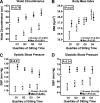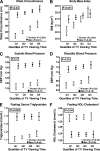Deleterious associations of sitting time and television viewing time with cardiometabolic risk biomarkers: Australian Diabetes, Obesity and Lifestyle (AusDiab) study 2004-2005
- PMID: 19918003
- PMCID: PMC2809275
- DOI: 10.2337/dc09-0493
Deleterious associations of sitting time and television viewing time with cardiometabolic risk biomarkers: Australian Diabetes, Obesity and Lifestyle (AusDiab) study 2004-2005
Abstract
Objective: We examined the associations of sitting time and television (TV) viewing time with continuously measured biomarkers of cardio-metabolic risk in Australian adults.
Research design and methods: Waist circumference, BMI, resting blood pressure, triglycerides, HDL cholesterol, fasting and 2-h postload plasma glucose, and fasting insulin were measured in 2,761 women and 2,103 men aged > or =30 years (mean age 54 years) without clinically diagnosed diabetes from the 2004-2005 Australian Diabetes, Obesity and Lifestyle (AusDiab) study. Multivariate linear regression analyses examined associations of self-reported sitting time and TV viewing time (hours per day) with these biomarkers, adjusting for potential confounding variables.
Results: For both women and men, sitting time was detrimentally associated with waist circumference, BMI, systolic blood pressure, fasting triglycerides, HDL cholesterol, 2-h postload plasma glucose, and fasting insulin (all P < 0.05), but not with fasting plasma glucose and diastolic blood pressure (men only). With the exception of HDL cholesterol and systolic blood pressure in women, the associations remained significant after further adjustment for waist circumference. TV viewing time was detrimentally associated with all metabolic measures in women and all except HDL cholesterol and blood pressure in men. Only fasting insulin and glucose (men only) remained deleteriously associated with TV viewing time after adjustment for waist circumference.
Conclusions: In women and men, sitting time and TV viewing time were deleteriously associated with cardio-metabolic risk biomarkers, with sitting time having more consistent associations in both sexes and being independent of central adiposity. Preventive initiatives aimed at reducing sitting time should focus on both nonleisure and leisure-time domains.
Figures




References
-
- Hu FB, Li TY, Colditz GA, Willett WC, Manson JE. Television watching and other sedentary behaviors in relation to risk of obesity and type 2 diabetes mellitus in women. JAMA 2003; 289: 1785– 1791 - PubMed
-
- Dunstan DW, Salmon J, Owen N, Armstrong T, Zimmet PZ, Welborn TA, Cameron AJ, Dwyer T, Jolley D, Shaw JEAusDiab Steering Committee. Associations of TV viewing and physical activity with the metabolic syndrome in Australian adults. Diabetologia 2005; 48: 2254– 2261 - PubMed
-
- Healy GN, Dunstan DW, Salmon J, Shaw JE, Zimmet PZ, Owen N. Television time and continuous metabolic risk in physically active adults. Med Sci Sports Exerc 2008; 40: 639– 645 - PubMed
-
- Dunstan DW, Salmon J, Healy GN, Shaw JE, Jolley D, Zimmet PZ, Owen NAusDiab Steering Committee. Association of television viewing with fasting and 2-h post challenge plasma glucose levels in adults without diagnosed diabetes. Diabetes Care 2007; 30: 516– 522 - PubMed
Publication types
MeSH terms
Substances
LinkOut - more resources
Full Text Sources
Medical

